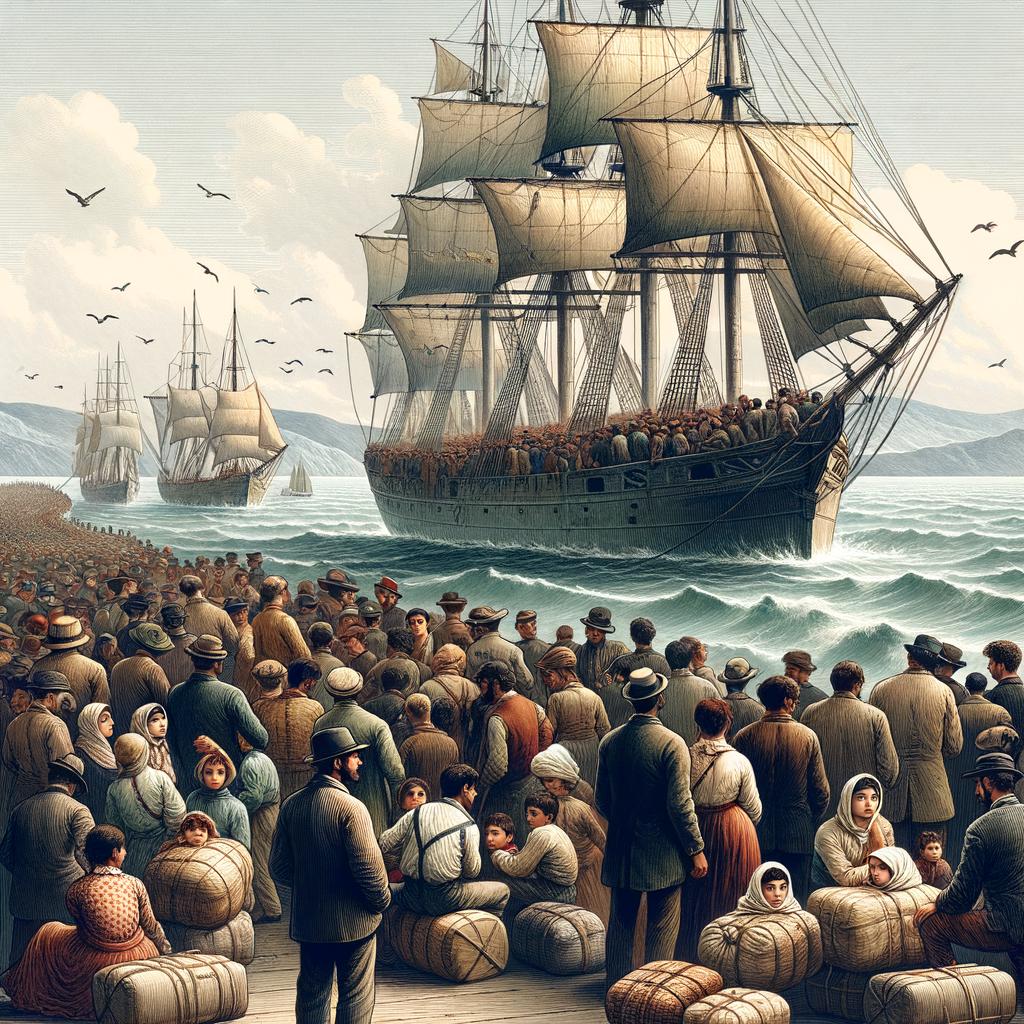Italian immigration to the United States has had a significant impact on American society, shaping the cultural and social landscape of the country. Understanding how Italian immigrants traveled from Italy to the US is crucial in appreciating their journey and contributions to American history. From economic hardships to hopes for a better future, the motivations behind their migration reflect a compelling narrative of resilience and determination.
During the late 19th and early 20th centuries, an influx of Italian immigrants arrived on American shores in search of better opportunities and escape from poverty and political instability. The journey from Italy to the United States was filled with challenges and risks, yet these immigrants embarked on it with hope for a brighter future for themselves and their families.
This article will delve into the push and pull factors that led to Italian immigration, as well as explore the methods of transportation used by Italian immigrants and the challenges they faced during their journey.
As we explore this topic further, we will gain insight into Ellis Island as a gateway for millions of immigrants entering America and how Italian immigrant communities formed across the country. Additionally, we will uncover the lasting legacy of Italian immigration, from its influence on American cuisine, art, and music to the enduring impact on American cities. Join us as we honor the journey of Italian immigrants to America and acknowledge their invaluable contributions to American society.
The Push Factors for Italian Immigration
Economic Hardships and Poverty in Italy
During the late 19th and early 20th centuries, Italy faced severe economic hardships and widespread poverty. The country’s economy was largely agrarian, and many Italians struggled to make a living from farming. Additionally, overpopulation in rural areas led to land scarcity, exacerbating the economic challenges faced by many Italians. As a result, countless individuals and families sought opportunities to improve their economic standing by leaving Italy for the United States.
Lack of Job Opportunities and Political Instability
Italian immigrants also fled their homeland due to a lack of job opportunities and political instability. The unification of Italy in the mid-19th century led to increased centralization, causing economic disparities between northern and southern regions. Southern Italy, in particular, experienced high unemployment rates and limited prospects for economic advancement. Furthermore, political unrest and corruption within the Italian government contributed to a sense of disillusionment among many Italians.
Social and Religious Discrimination in Italy
In addition to economic and political factors, social and religious discrimination played a significant role in driving Italian immigration to the United States. Southern Italian immigrants, in particular, faced discrimination based on their regional origins as well as their Catholic faith.
They were often marginalized by the wealthier northern Italians and faced limitations in terms of social mobility. This discrimination fueled the desire of many Italian immigrants to seek a more accepting environment where they could build better lives for themselves and their families.
Overall, it is clear that the push factors for Italian immigration were deeply rooted in the various challenges faced by individuals and families in their homeland. Understanding these hardships provides valuable insight into why so many Italians made the arduous journey from Italy to the US during this time period.
The Pull Factors for Italian Immigration
Italian immigrants were drawn to the United States by a variety of pull factors that promised a better life for them and their families. The promise of better economic opportunities in the US was a major driving force behind Italian immigration.
With poverty and lack of job opportunities prevalent in Italy, many Italians saw America as a land of opportunity where they could find work and improve their financial circumstances. The stories of success from Italian immigrants who had already settled in America further fueled the hope for a brighter future, encouraging others to make the journey across the Atlantic.
In addition to economic prospects, the promise of freedom and equality in America also attracted Italian immigrants. Italy faced political instability and social and religious discrimination during the late 19th and early 20th centuries, prompting many Italians to seek refuge in the United States where they believed they could have greater opportunities for social and political mobility.
The ideal of America as a place where individuals could achieve success regardless of their background or social status was a powerful draw for Italian immigrants seeking to escape the challenges they faced in their homeland.
The hope for a better future for their families also played a crucial role in motivating Italian immigrants to travel to the US. Many sought to provide improved living conditions, education, and opportunities for their children that were not readily available in Italy. As a result, families often made great sacrifices to undertake the challenging journey from Italy to America, driven by the desire to build a more prosperous and secure life for themselves and future generations.
The Journey From Italy to America
Italian immigrants made the journey from Italy to America during a time when the country was facing significant economic hardships, political instability, and social discrimination. These push factors were a driving force behind the wave of Italian immigration to the United States in search of better opportunities and a brighter future for their families. Understanding how Italian immigrants traveled from Italy to the US provides valuable insight into their resilience and determination in pursuit of a new life.
Methods of Transportation
The journey from Italy to America was often long and arduous, with Italian immigrants primarily traveling by steamships across the Atlantic Ocean. These steamships offered the only viable mode of transportation for mass migration at the time. Many Italian immigrants traveled in steerage, or third-class accommodations, which were cramped and unsanitary. This mode of transportation reflected the difficult circumstances that compelled them to leave their homeland in search of better prospects in America.
Challenges and Dangers
The voyage across the Atlantic presented numerous challenges and dangers for Italian immigrants. Overcrowding, poor ventilation, and limited access to basic amenities made for harsh living conditions on the ships. Additionally, there were risks of illness, malnutrition, and even death during the journey.
The uncertainty of what awaited them in America added emotional strain to an already grueling experience. Despite these difficulties, Italian immigrants remained resilient as they navigated through this challenging journey with hope for a better life awaiting them on American soil.
Length of Journey and Living Conditions
The journey from Italy to America typically lasted around one to two weeks, depending on weather conditions and other external factors. During this time, Italian immigrants endured confined living quarters without proper sanitation facilities or adequate food supplies. The physical discomfort combined with feelings of apprehension about the unknown awaited them on arrival in America further underscores their remarkable courage and determination throughout this arduous journey.
Ellis Island and Immigration Process
The journey from Italy to America for Italian immigrants was a long and arduous one, filled with challenges and dangers. Many Italian immigrants traveled by steamship, enduring cramped and unsanitary conditions for weeks at a time.
The journey was not only physically demanding but also emotionally taxing, as many immigrants left behind their families and homeland in search of better opportunities in America. The decision to embark on this journey was often made out of necessity due to economic hardships, lack of job opportunities, and social and religious discrimination in Italy.
Upon arrival in the United States, Italian immigrants faced the daunting immigration process at Ellis Island. They were processed through various inspections and medical examinations before being allowed to enter the country. This process could be overwhelming as immigrants had to navigate a new language and culture while undergoing scrutiny from immigration officials. However, for many Italian immigrants, Ellis Island also represented hope and the prospect of reuniting with family members who had already established themselves in America.
Despite the challenges they faced, Italian immigrants ultimately contributed significantly to American society. Their influence can be seen in various aspects of American culture, from cuisine and art to music and entertainment. Italian immigrant communities formed close-knit neighborhoods that preserved their cultural heritage while adapting to American life. Through their hard work and determination, Italian immigrants have left a lasting legacy that continues to shape the United States today.
Understanding how Italian immigrants traveled from Italy to the US provides valuable insight into their experiences and contributions to American society. By honoring their journey and acknowledging their impact, we can appreciate the enduring legacy of Italian immigration on the United States.
Italian Immigrant Communities in the United States
Italian immigrants faced many challenges as they arrived in the United States, but they were able to find solace and support by settling into Italian immigrant communities. These communities were formed by Italians who shared a common language, culture, and background. As a result, Italian neighborhoods began to emerge where immigrants could feel a sense of belonging and familiarity in their new home.
Often, Italian immigrants would settle in urban areas where work opportunities were more abundant. Cities such as New York, Boston, Chicago, and Philadelphia became major hubs for Italian immigrant communities. Within these neighborhoods, Italian culture flourished as residents established businesses, churches, and social organizations that preserved their heritage.
While the formation of these communities provided comfort and support for Italian immigrants, it also presented challenges as they adapted to American society. Discrimination and prejudice against Italians were prevalent at the time, leading to social and economic barriers within these immigrant enclaves. Despite this adversity, Italian immigrant communities found resilience and solidarity in preserving their cultural traditions and values.
Over time, the influence of these Italian immigrant communities has left a lasting impact on American society. Their contributions can be seen in various aspects of American culture such as cuisine, music, architecture, and art. Additionally, the strong sense of community fostered by Italian immigrants has continued to resonate through generations of Italian Americans living in the United States today.
Contributions of Italian Immigrants to American Society
Italian immigrants have made significant contributions to American society in various aspects, including cuisine, art, and music. One of the most notable influences of Italian immigrants is on American cuisine. Many popular dishes in the United States, such as pizza and pasta, have their origins in Italy and were introduced to American culture by Italian immigrants. The culinary traditions brought from Italy have greatly enriched the American food scene, with Italian restaurants becoming a staple in cities across the country.
In addition to food, Italian immigrants have also left a lasting impact on the art and music scene in America. Italian artists and musicians brought their talents and cultural traditions with them, contributing to the vibrant artistic landscape of the United States. From classical music composers to renowned painters, Italian immigrants have played a pivotal role in shaping American art and music.
Furthermore, Italian Americans have also made significant achievements in politics, sports, and entertainment. Many prominent figures in these fields are descendants of Italian immigrants who have excelled and made their mark on American society. Their accomplishments serve as a testament to the resilience and determination of Italian immigrants in pursuing success and making valuable contributions to their adopted country.
Below is an example of how you can include relevant data from your response into an HTML table.
| Area of Contribution | Impact |
|---|---|
| American Cuisine | Popularization of pizza and pasta |
| Art and Music | Enriched artistic landscape |
| Politics, Sports, Entertainment | Significant achievements by descendants of Italian immigrants |
The Legacy of Italian Immigration
Italian immigrants played a significant role in the development and enrichment of American society. Their journey from Italy to the United States was marked by challenges and hardships, but their contributions have left a lasting impact on the cultural, culinary, and artistic landscape of the country. Today, descendants of Italian immigrants continue to preserve their heritage and traditions while participating fully in American life.
The legacy of Italian immigration to the United States is evident in various aspects of American society. One notable contribution is the influence on American cuisine, with Italian dishes such as pizza, pasta, and gelato becoming staples in the American diet. Additionally, Italian immigrants have made substantial contributions to art and music in the US, with many Italian Americans excelling in diverse fields such as opera, classical music, and visual arts.
Italian Americans have also made their mark in politics, sports, and entertainment. Many politicians at local and national levels have Italian heritage, contributing to decision-making processes and governance in the United States. In sports and entertainment, Italian Americans have excelled as athletes, actors, directors, and producers, enriching American culture with their talents and achievements.
| Key Statistic | Data |
|---|---|
| Number of Italian immigrants to the US between 1820-2004 | 3 million |
| Percentage of Italians among European emigrants who arrived in America between 1880-1920 | about 80% |
| Top states for Italian immigrant settlement | New York, New Jersey, California |
Italian immigrants continue to honor their journey by preserving their cultural heritage while embracing their identity as Americans. The enduring legacy of Italian immigration is not only felt through tangible contributions such as food or art but also through the values of hard work< important point on "the pull factors for italian immigration" that came up earlier>, family unity
Conclusion
In conclusion, the journey of Italian immigrants from Italy to the United States is a testament to their resilience, determination, and enduring hope for a better future. Understanding how Italian immigrants traveled to the US provides valuable insight into the push and pull factors that drove their migration, as well as the challenges they faced along the way.
From economic hardships and social discrimination in Italy to the promise of better opportunities in America, Italian immigrants embarked on a journey that would ultimately shape the cultural landscape of the United States.
The legacy of Italian immigration continues to be honored and celebrated in American society today. Italian influence can be seen in various aspects of American culture, from cuisine and art to music and entertainment. The contributions of Italian immigrants have left an indelible mark on the development of American cities, politics, and sports. Furthermore, their descendants continue to preserve and celebrate their Italian heritage and traditions, ensuring that the enduring legacy of Italian immigration is cherished for generations to come.
In honoring the journey of Italian immigrants to America, it is important to recognize and acknowledge the hardships they endured, as well as their remarkable contributions to American society. The story of Italian immigration is one of courage, perseverance, and resilience in the face of adversity.
By reflecting on this journey, we gain a deeper appreciation for the diversity and richness that immigrants have brought to the United States throughout its history. How did Italian immigrants travel from Italy to US has not only shaped American culture but also enriched it in countless ways.
Frequently Asked Questions
What Ship Did Italian Immigrants Take to America?
Italian immigrants primarily took steamships to America, with many traveling on famous ships like the SS Rex, SS Conte di Savoia, and SS Andrea Doria. These ships offered passage for thousands of immigrants seeking a new life in America.
What Port Did Italian Immigrants Leave From?
The majority of Italian immigrants left from ports in Italy, such as Genoa, Naples, and Palermo. These ports were major departure points for transatlantic journeys to the United States and other destinations.
How Did Italian Immigrants Spend Their Time on the Ship as They Traveled to America?
During their journey to America, Italian immigrants spent their time on the ship enduring long voyages that lasted several weeks. They often crowded together in cramped steerage class quarters, enduring rough seas and limited amenities while trying to pass the time through singing, talking, or playing cards. Some may have experienced sea sickness or other discomforts during the voyage.

I’m a passionate traveler, writer, and Italophile. My fascination with Italy’s history, art, and culture has led me on countless adventures across the Italian landscape. Through “I Live Italy,” I share my love for this extraordinary country and aims to inspire others to explore its boundless beauty.





